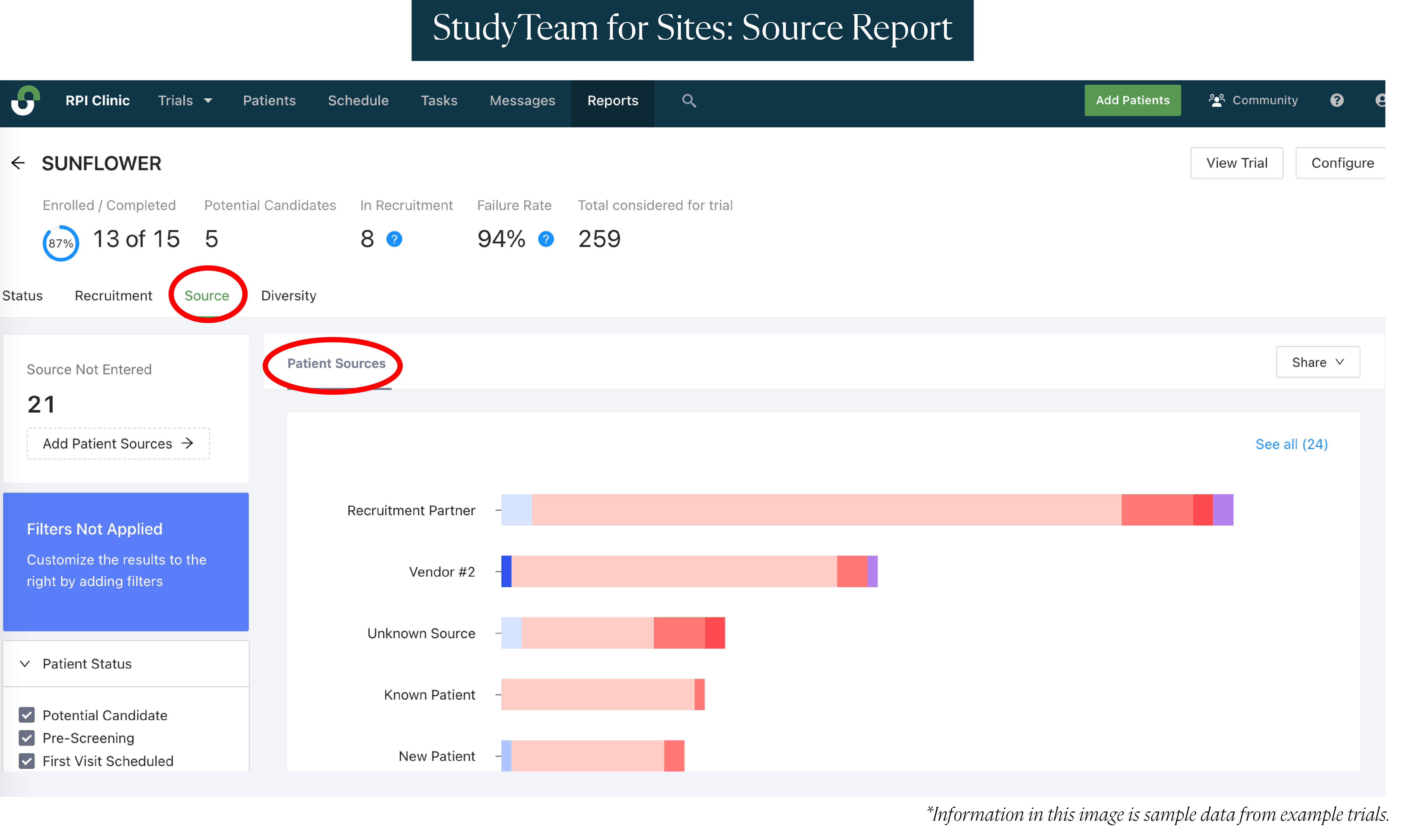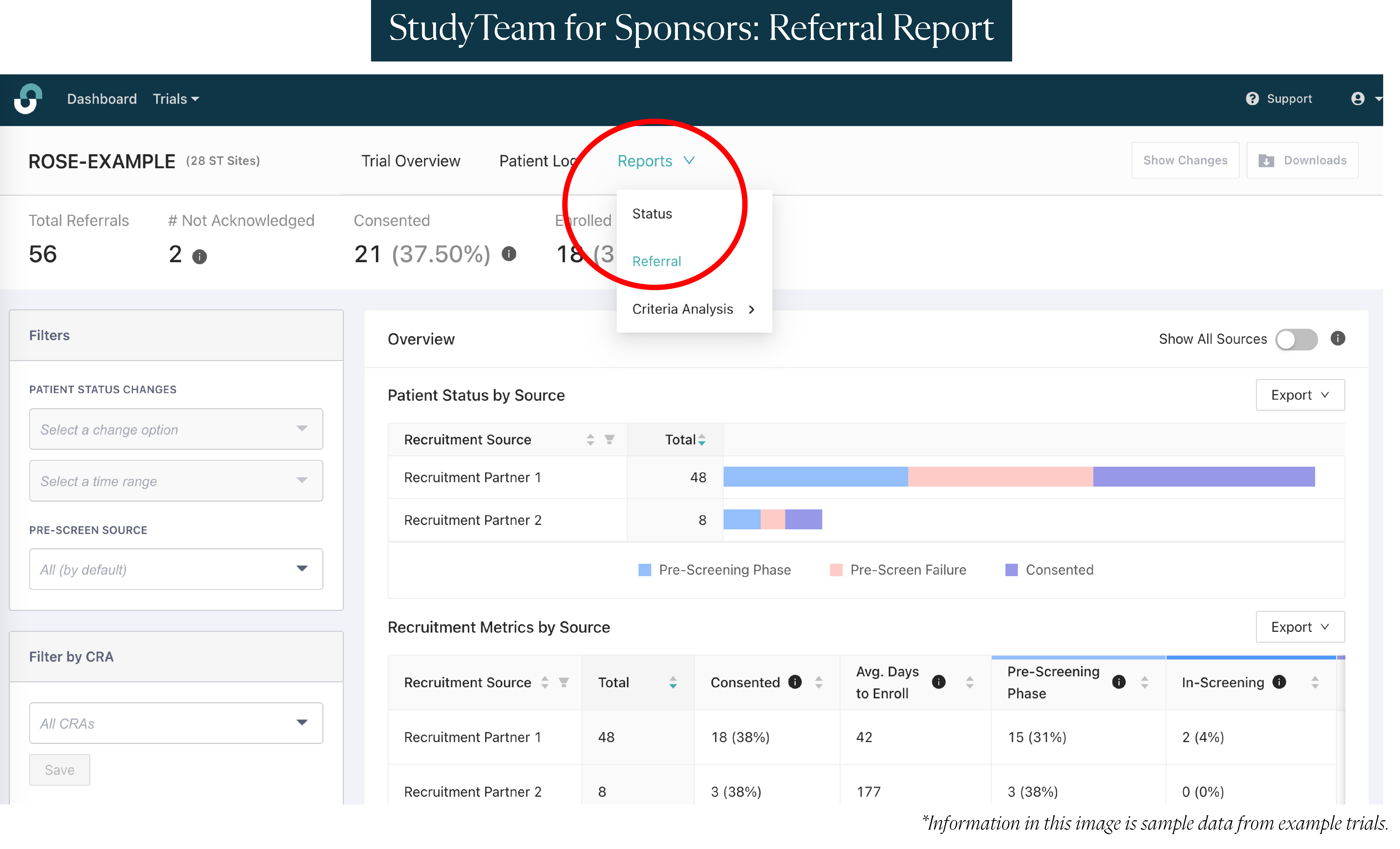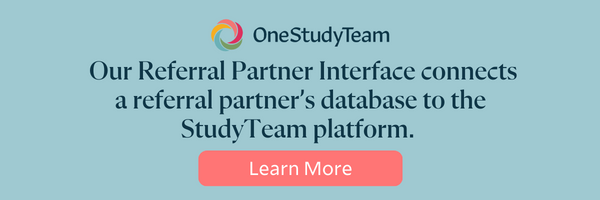Patient recruitment for clinical trials is a critical period when potentially eligible patients are identified and recruited for pre-screening. “Recruitment for clinical trials is hard, as evidenced by the fact that most trials miss their enrollment deadline,” said Alex Eastman, Vice President of Product at OneStudyTeam. “Yet quantitative data that gives insight into why that is has historically been hard to acquire.”
During the recruitment phase, site teams may examine patient information via chart review and they may even input that information into spreadsheets. But there’s often no formal process for storing or sharing that initial recruitment data. “That’s why digital transformation in clinical trials is important to understand what works and what doesn’t,” Eastman said.
Here are three benefits of collecting clinical trial patient recruitment data in an organized, digital database.
(1) It’s easier for sites and sponsors to identify which recruitment sources are performing well and which are not.
“When working to understand what works for recruitment and what doesn’t,” Eastman said, “you need insight into which sources of patients tend to be the most effective or productive: sites’ own recruitment efforts or sponsor-initiated recruitment programs, or a blend of both?”
These insights aren’t easy to pull if sites aren’t adding recruitment source information into digital patient databases. With a digital database, site teams can easily add that information along with other patient pre-screening information. With the cloud-based StudyTeam patient enrollment management platform, sites can even receive patient referrals from recruitment partners that automatically include source information; these referrals are streamlined right into their patient database through a referral partner integration.
To check recruitment progress via their digital database, sites can filter by sources (StudyTeam offers a Source Report) to see which sources are bringing in more eligible patients. Maybe the majority of their actively enrolled patients were sourced from a site-driven Facebook ad, while a newspaper ad brought in a handful of patients who then pre-screen failed. Sites can quickly determine if they want to adjust their advertising budget based on this information.

Sponsors can make adjustments in their recruitment programs based on this source information entered into digital site databases as well – a digital platform makes it easy for that information to become shareable. With StudyTeam, sponsors can automatically view recruitment insights (in a Referral Report) to see which recruitment sources are leading to higher conversion to screening and enrollment phases. This way, sponsors can determine which recruitment programming is best for which sites.

(2) Sponsors can understand earlier during the enrollment process why patients are dropping out of the funnel – and take meaningful action.
Because recruitment data is collected throughout the pre-screening process before informed consent, this data represents the earliest possible insights sponsors can get about potential trial participants. In addition to adding recruitment source information for each patient in their database, it’s ideal for sites to include information like:
- Inclusion/exclusion criteria failures
- Race and ethnicity
- Reasons patients decline to participate
When these insights are available and shareable with sponsors via a digital system, sponsors can quickly answer the following questions as they analyze recruitment progress and barriers:
- Why are patients who are considered potential candidates for a trial declining to participate, or which eligibility criteria rule them out?
- Why are diverse populations underrepresented in clinical trials? Are they underrepresented within the pool of candidates considered? Or do they drop out of the recruitment process at disproportionate rates?
StudyTeam automatically pulls site data to generate reports for sponsors that depict this progress: I/E Criteria Reports, Reasons Declined Reports, and Diversity Reports. When sponsors source this early, pre-enrollment information provided by their sites, they can use these insights to course correct by addressing specific challenges before trial timelines get off track.
(3) Recruitment data stored in a secure digital database is less risky than paper files.
Any sort of patient data on paper is risky – there’s the risk of physical damage to those documents in a storage space, as well as the risk of unauthorized people seeing that information. When sites build out a digital database with recruitment data, they can choose technology that:
- Is equipped with secure logins to limit data visibility to only authorized users;
- Has the ability to transfer that information to authorized sponsor teams in a de-identified manner;
- Is designed with technical and organizational safeguards to ensure compliance with data protection principles.
With StudyTeam, built-in data privacy protections ensure sites and sponsors act as data controllers in their separate applications: StudyTeam for Sites and StudyTeam for Sponsors, respectively. Each data controller is empowered to choose which data goes into the software, where it is transferred, and how long it is retained.
When sites go digital with their workflows using the right platform, they can easily and securely gather clinical trial patient recruitment data to assess progress and share insights with their sponsors.
StudyTeam was designed as a single, central platform to make patient visit management, as well as pre-screening data collection, easier for site teams throughout the enrollment process.
“When sites have to use separate systems for recruitment activities, they often have to manually duplicate data (e.g., patient information) across each system,” Eastman said. “By using a single system that supports all recruitment activities in an integrated way, sites can save themselves significant time and effort.”
That includes efficiently monitoring and assessing recruitment progress, while enabling their sponsors to do the same.
- SEO Powered Content & PR Distribution. Get Amplified Today.
- PlatoData.Network Vertical Generative Ai. Empower Yourself. Access Here.
- PlatoAiStream. Web3 Intelligence. Knowledge Amplified. Access Here.
- PlatoESG. Automotive / EVs, Carbon, CleanTech, Energy, Environment, Solar, Waste Management. Access Here.
- BlockOffsets. Modernizing Environmental Offset Ownership. Access Here.
- Source: https://blog.onestudyteam.com/clinical-trial-patient-recruitment-data-digital-database




